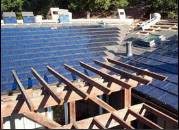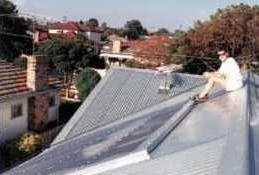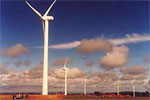Renewable Energy
Home | Introduction | News | Resources
Renewable Energy |
|
|
Home | Introduction | News | Resources |
|
Renewable or sustainable energy refers to energy resources which will never run out.
We would also expect renewable energy to be 'green' or clean energy, that is, generating the
energy produces minimal pollution and greenhouse gases, and doesn't leave dangerous
waste products, or endanger lives or wildlife.
The main sources of renewable energy are solar energy,
wind energy,
tidal and wave energy, biomass energy,
and geothermal energy.
Good descriptions of the technology and uses of renewable energy can be found at
the Australian Greenhouse Office website, and at the
National Renewable Energy Laboratory (U.S.A.)
![]() Photovoltaics.
Photovoltaics.
Photovoltaics use solar cells to convert light into electricity. The cells require only light
and not sunlight, and are effective even on cloudy days.
Schemes such as 'One Million
Solar Roofs' in the U.S.A., and similar
schemes in Britain and
Germany capture
the public's imaginations.
There are now several examples
of 'solar houses' relying on photovoltaics to provide some or all of their electricity
requirements - for example,
Power Of One.
in South Australia
In February 2000, the Federal Government announced a $31 million program to pay cash
rebates of up to $8250 - or $5.50 per watt - for solar panels,
effectively halving the cost of an average panel.
It is also possible to obtain credit from electricity companies for any surplus electricity
generated and fed back into the grid. Stuart MgGovern has the first demonstration
of such a scheme in his house in Melbourne:
Powering towards
some give and take.
 Integration of solar cells in building materials is also becoming more available,
for example as
solar roof tiles.
A solar tile is a photovoltaic (PV) module and a connection box,
laminated together and glued to the surface of a unit of roofing material,
such as a slate made of lightweight concrete.
The first
house in Britain to have the roof completely
covered with solar roof tiles was commissioned in 1999. The picture on the right shows
a house in California
being constructed using solar roof tiles.
The 5KW system should generate 3500 KWh of electricity per year. A
project
in Kogarah, NSW
to use building
integrated photovoltaics in a public building is underway, with funding
of $1 million from the Australian Greenhouse Office. The building will incorporate
160-200Kw modular PV roofing systems.
Integration of solar cells in building materials is also becoming more available,
for example as
solar roof tiles.
A solar tile is a photovoltaic (PV) module and a connection box,
laminated together and glued to the surface of a unit of roofing material,
such as a slate made of lightweight concrete.
The first
house in Britain to have the roof completely
covered with solar roof tiles was commissioned in 1999. The picture on the right shows
a house in California
being constructed using solar roof tiles.
The 5KW system should generate 3500 KWh of electricity per year. A
project
in Kogarah, NSW
to use building
integrated photovoltaics in a public building is underway, with funding
of $1 million from the Australian Greenhouse Office. The building will incorporate
160-200Kw modular PV roofing systems.
![]() Solar Heating
Solar Heating
Solar Heating is making using the sun's thermal energy to heat water or air typically
for domestic water heating and space heating.
Solar heating has also been used in large scale projects such as
heating a 96 house estate in Beijum, Netherlands.
54% of total heat requirements was met by the solar energy system.
(more info, pdf file).
Solar air heaters can be used to
preheat ventilation air in
office and factory buildings,
for heating farm buildings,
and for drying crops such as tea.
Solar water heaters are fairly common on
Australian roofs. A typical system will reduce the need for conventional water
heating by about two-thirds. You can get a $500
rebate for installing a solar water heater.
What's new in 2002 for Solar Water Heating?

Solar air heating systems are
a straightforward yet effective way
of using solar energy for space heating.
They offer some unique advantages over solar water systems, and can offer
improved comfort and fuller use of solar gains than passive solar systems.
They can be economical,
with short pay-back periods and can act not only as space heating or ventilation
air heating but also for water pre-heating, electricity generation
(with hybrid
photovoltaic systems) and can help induce cooling.
(Solar Air Systems: A Design Handbook)
Solar air heaters have another advantage - they are relatively easy for the home owner
to construct themselves using readily available building materials.
![]() Concentrating Solar Power
Concentrating Solar Power
 Concentrating solar power technologies use reflective materials such as mirrors to
concentrate the sun's energy. This concentrated heat energy is then
converted into electricity.
Concentrating solar power systems can be sized for village power (10 kilowatts)
or grid-connected applications (50 to 200 megawatts). Some systems use thermal
storage during cloudy periods or at night.
There are three kinds of concentrating solar power systems—troughs, dish/engines,
and the impressive power towers
(picture on right of Sandia SunLab's Solar Two power tower).
The first commercial power tower plant is planned to be four times
the size of Solar Two (about 40 MW equivalent, utilizing molten salt for thermal
storage to power a
15MW turbine up to 24 hours per day).
See the links at the top for more information.
Concentrating solar power technologies use reflective materials such as mirrors to
concentrate the sun's energy. This concentrated heat energy is then
converted into electricity.
Concentrating solar power systems can be sized for village power (10 kilowatts)
or grid-connected applications (50 to 200 megawatts). Some systems use thermal
storage during cloudy periods or at night.
There are three kinds of concentrating solar power systems—troughs, dish/engines,
and the impressive power towers
(picture on right of Sandia SunLab's Solar Two power tower).
The first commercial power tower plant is planned to be four times
the size of Solar Two (about 40 MW equivalent, utilizing molten salt for thermal
storage to power a
15MW turbine up to 24 hours per day).
See the links at the top for more information.
![]() Solar Hydrogen and Fuel Cells.
Solar Hydrogen and Fuel Cells.
Solar Hydrogen is hydrogen produced by using solar energy to split water into its components,
oxygen and hydrogen. The hydrogen gas can then be stored and used as a fuel source for
fuel cells
(The Solar Hydrogen Cycle).
Fuel cells, discovered in 1839, produce electricity by electrochemically combining hydrogen and
oxygen from the air. Heat and pure water vapor are the only by-products from this reaction.
Fuel cells offer the promise of low emission power for
motor vehicles, and electricity and heat for towns using local cogeneration plants.
Fuel Cells, Green Power.
![]() Solar Ponds
Solar Ponds
A solar pond is basically a man-made salty lake which collects and stores solar energy.
Salt water being heavier than fresh water does not rise or mix by natural convection.
creating a large temperature gradient within the pond. Fresh water forms
a thin insulating surface layer at the top, and underneath it is the salt water,
which becomes hotter with depth - as hot as 90 degs C at the bottom. The result is a
solar collector with built in thermal storage.
Although they can provide heat for other applications, the most common use for solar
salt gradient ponds is the generation of electricity. Heated brine is drawn from
the bottom of the pond and piped into a heat exchanger, where its heat converts a
liquid refrigerant into a pressurized vapor which spins a turbine, generating
electricity.
An Israeli project covering nearly 62 acres near
the Dead Sea produces up to 5 MW of electricity during peak demand periods.
A 6000 sq. metre
Solar Pond in Bhuj, India
is capable of delivering 80,000 litres of hot water daily, at 70 degrees C or above, for
heating a dairy plant. The cost of the pond was US $90,000 (1997 prices), and has
an annual fuel cost saving of US $19,000.
In Australia, a project by Pyramid Salt in Victoria has obtained $500,000 funding
from the Australian Greenhouse Office to develop a 3000 sq. metre salt pond
The pond will produce 60 kilowatts of thermal energy in the form of heat,
at temperatures between 45 and 80 degrees Celsius,
providing hot air for the salt factory,
"but it's hoped it'll one day power the factory, and put excess electricity
into the power grid" -
feature story on ABC Landline, 8/9/2001.
![]() Wind Energy.
Wind Energy.
Wind turbines are being seen in increasing numbers on the rural landscape of
Australia - Wind Farms
Take Off .
These modern windwills up to 30 metres high with turbine blades several metres long
costing $1 million each
are connected to the electicity power grid.
 Crookwell Wind Farm in
NSW was the first grid-connected wind farm in
Australia when installed by Pacific Power in 1998. It consists of eight
600kW turbines giving a total capacity of 4.8MW.
Wind turbines can be also used in stand-alone applications,
or even combined with a
photovoltaic (solar cell) system. Stand-alone wind turbines are typically
used for water pumping or communications. Small-scale wind energy systems can
also be used by homeowners or farmers in
windy areas to cut their electric bills.
Plan for 130MW Wind farm in Tasmania.
Crookwell Wind Farm in
NSW was the first grid-connected wind farm in
Australia when installed by Pacific Power in 1998. It consists of eight
600kW turbines giving a total capacity of 4.8MW.
Wind turbines can be also used in stand-alone applications,
or even combined with a
photovoltaic (solar cell) system. Stand-alone wind turbines are typically
used for water pumping or communications. Small-scale wind energy systems can
also be used by homeowners or farmers in
windy areas to cut their electric bills.
Plan for 130MW Wind farm in Tasmania.
 Wind energy is the fastest growing sectors of the renewable energy industry.
In the U.K. for example, the total wind generating capacity now stands at 473.6 megawatts, with
64.6 new megawatts installed in 2001. The corresponding annual
electricity production is 1.24TWh, or 0.37% of UK demand. Denmark, however, can generate 14% of the
country's electricity using wind energy.
Wind energy is the fastest growing sectors of the renewable energy industry.
In the U.K. for example, the total wind generating capacity now stands at 473.6 megawatts, with
64.6 new megawatts installed in 2001. The corresponding annual
electricity production is 1.24TWh, or 0.37% of UK demand. Denmark, however, can generate 14% of the
country's electricity using wind energy.
![]() Geothermal.
Geothermal.
Geothermal energy is the generation of energy from the earth's heat, either
directly from hot water within the earth, or using heat pumps to heat and cool
buildings, or to produce electricity. Geothermal energy has a vast potential -
A single plant could power entire UK.
You can read a good overview at the
Australian Renewable Energy website
![]() Water Power - hydro, tidal and wave energy
Water Power - hydro, tidal and wave energy
There are several successful projects around
the world making use of high levels of
tidal changes to generate power.
In Australia a
proposed $100 million scheme to build a 48MW tidal power station in the Derby region of
Western Australia has received mixed support from Government and
Greens. The project
was initially rejected in favour of gas powered electricity generation, but has obtained
funding of
$1 million to
develop the project further.
![]() Bioenergy
Bioenergy
Bioenergy is the energy obtained from plant and plant products.
Fossil fuels of course originated from plant material which became buried and compressed millions
of years ago. However, bioenergy usually refers to energy from recently-grown plant material,
which can be grown and harvested sustainably.
The most common form of
bioenergy is burning wood for heating.
Burning wood individually in open fires or woodheaters is probably the least 'green' use
of biomass energy. Domestic wood burning is responsible for emissions of
particulates (PM2.5) - associated with short-term and long-term adverse health effects,
volatile organic
compounds and polycyclic organic hydrocarbons (PAH) - carcinogenic air pollutants,
and methane
a greenhouse gas 21 times more powerful than carbon dioxide,
- constituents of woodsmoke.
Woodsmoke pollution from domestic heaters is a problem in many residential areas of
Australia (EPA
Information on Woodsmoke).
More efficient and cleaner uses of bioenergy include
 Biomass may also be required to produce biofuels, such as wood ethanol, methanol,
and biodiesel,
as replacements for petroleum based products which will eventually run out
(Getting Over Oil).
Biofuels
are claimed to have reduced emissions of particulates, hydrocarbons, carbon monoxide,
nitrogen dioxide and sulphur.
Australia's future fuel source?
Biomass may also be required to produce biofuels, such as wood ethanol, methanol,
and biodiesel,
as replacements for petroleum based products which will eventually run out
(Getting Over Oil).
Biofuels
are claimed to have reduced emissions of particulates, hydrocarbons, carbon monoxide,
nitrogen dioxide and sulphur.
Australia's future fuel source?
| Are you burning their homes to warm yours? |

|
|
|
|
|
|
Home | Introduction |
News | Resources Solar Heating | Energy Efficiency | Renewable Energy | Solar Retrofit |
|
|
|
|
Page created on Thursday, 9 August 2001. |
|